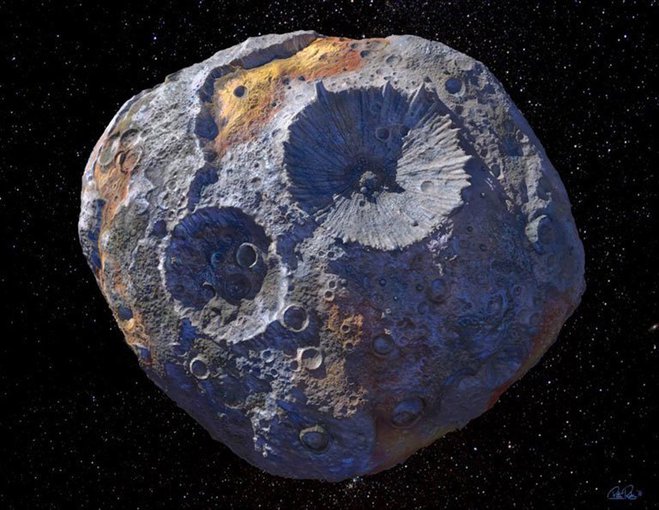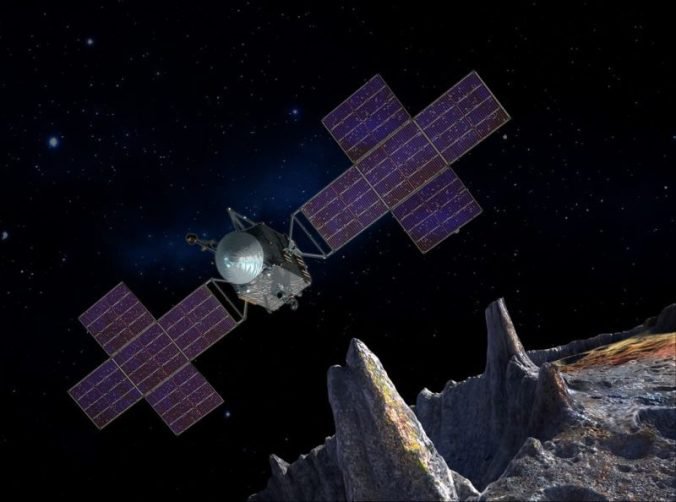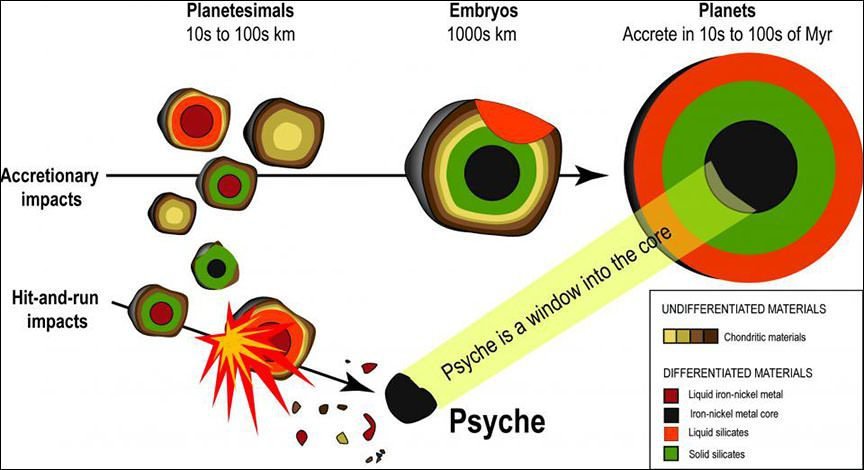
Deep inside the rocky planets of our solar system, as well as some Solar System moons, is an iron-based core.
Some, such as Earth’s core, have an inner solid phase and outer molten phase, but the Solar System cores studied so far are of significantly varied sizes and contain a pretty wide variety of elements alongside the iron. Mercury, for instance, is 85 percent core by volume and made up largely of iron, while our moon’s core is thought to be 20 percent of its volume and is mostly iron with some sulfur and nickel.

The asteroid Psyche will be the first metal-rich celestial body to be visited by a spacecraft. The NASA mission launches in 2022 and is expected to arrive at the asteroid in late 2026. A central question to be answered is whether Psyche is the exposed core of a protoplanet that was stripped of its rocky mantle.Image credit: NASA.
Iron cores like our own play a central role in creating a magnetic field around the planet, which in turn holds in the atmosphere and may well be essential to make a planet habitable. They are also key to understanding how planets form after a star is forged and remaining dense gases and dust are kicked out to form a protoplanetary disk, where planets are assembled.
So cores are central to planetary science, and yet they are obviously hard to study. The Earth’s core starts about 1,800 miles below the surface, and the cores of gas giants such as Jupiter are much further inward, and even their elemental makeups are not fully understood.
All this helps explains why the upcoming NASA mission to the asteroid Psyche is being eagerly anticipated, especially by scientists who focus on planetary formation.
Scheduled to launch in 2022, the spacecraft will travel to the main asteroid belt between Mars and Jupiter and home in on what has been described as an unusual “metal body,” which is also one of the largest asteroids orbiting the Sun.
While some uncertainty remains, it appears that Psyche is the exposed nickel-iron core of a long-ago emerging rocky protoplanet, with the rest of the planet stripped away by collisions billions of years ago.

An artist’s illustration of solar system formation, and the formation of a protoplanetary disk filled with gases and dust that over time clump together and smash into each other to form larger and larger bodies.Image credit: Gemini Observatory/AURA/Lynette Cook.
That makes Psyche a most interesting place to visit.
“This will be our first visit to what may well be the insides of a once larger body,” said Lindy Elkins-Tanton of Arizona State University, the principal investigator of the Psyche mission. “So we have the possibility of exploring an early Solar System object made of metal that can help us understand our own core and many others.
“We hope Psyche will be bizarre and give us many insights into how planets start,” she told me.
Some of the surprises have come well before launch.
When it was initially selected for a NASA mission in 2017, the asteroid — about the size of Massachusetts — was thought to be 90 percent metal, mostly iron and nickel.
But now that scientists are studying Psyche more intensely, they have found that it appears to have significantly more rock content than earlier understood. In a recent paper in The Journal of Geophysical Research: Planets, Elkins-Tanton and colleagues concluded that the metal probably makes up between 30 to 60 percent of the asteroid’s volume.
“There are still contradictions in the compilations of all current data, but they suggest that Psyche is more of a mixture of rock and metal,” said Elkins-Tanton, a planetary scientist.
“If that is the case, this composition may provide additional clues to how Psyche was formed, and perhaps we will discover an unexpected stage of planet formation.”
In other words, the presence of the iron-silicate rock along with the metallic iron in what appears to be the exposed core of a protoplanet potentially makes the asteroid even more enigmatic, and intriguing.

Image credit: NASA/JPL-Caltech/Arizona State Univ./Space Systems Loral/Peter Rubin.
This kind of pre-launch exploration of Psyche is typical of NASA missions, where the selection of a target body leads to an often dramatic expansion in observations and research.
While up-close measurements are needed to more conclusively understand what Psyche is and what it is not, the work being done now and going forward provides a series of hypotheses to be explored, confirmed or rejected based on actual conditions observed,
The main NASA science goals for the mission are to learn much more about iron cores — previously unexplored building blocks of planet formation — and to, in effect, look deep inside a rocky planet like our own by examining an exposed core.
Said Elkins-Tanton: “We learn about inner space by visiting outer space…This is the only way humans will ever visit a core.”
To do that, the mission will use instruments including a cameras that can examine Psyche in numerous spectral wavelengths to discriminate between metallic and silicate components; a Gamma Ray and Neutron Spectrometer to detect, measure, and map Psyche’s elemental composition; and an X-band radio telecommunications system to measure Psyche’s gravity field to high precision. When combined with topography derived from onboard imagery, this will provide information on the interior structure of Psyche.
Not surprisingly, the Pysche spacecraft will also carry a magnetometer to measure the asteroid’s remaining magnetism—the direction, strength, or relative change of the magnetic field present.

Planets start as small planetesimals (10-100 kilometers across) and grow by gathering up material from new impacts until becoming large enough to serve as embryos for planets. Psyche may have started down the road of planethood only to be chopped down to size by hit-and-run impacts that broke away at its rocky envelope.Image credit: Arizona State University.
Psyche is often called a “metal world,” but that can be a somewhat confusing description. This is because the word “metal” has different definitions in the fields of astrophysics, chemistry and physics.
So I asked Timothy McCoy, curator of the meteorite collection for the Smithsonian’s National Museum of Natural History and a member of the Psyche team, what “metal” means in this situation
“At the small scale,” he told me, “metal in the context of Psyche simply describes the fact that iron (and a bit of nickel) are not combined with either oxygen or silicon. They are a metal as the average person would think of a bridge made of metal.”
As for a ‘metal world,’ he said, Psyche differs from other planetary bodies in that the presence of metal — rather than silicates (rock) or ice or gases — tells the story of how the asteroid formed to how it responds to impacts. Other asteroids and meteorites that crash into a metal body form a unique crater pattern.
McCoy said that even if Psyche turns out to have the lower estimates of metal concentration, “these are still greater than other asteroids we have explored and metal may well dominate the history of the asteroid.”
Planetary and lunar cores are formed through planetary differentiation, the process by which more dense elements like iron and nickel sink to the center of the evolving planet.
This descent of metals often takes place in magma oceans — which form after planetary embryos (moon and Mars-sized for Earth) collide, turn everything into liquid or plasma, and then over time settle back down into something planet-shaped but molten, perhaps entirely so.
Planetary cores are challenging to study because they are impossible to reach by drill and there are almost no samples that are definitively from the core. Alternative techniques such as seismology, mineral physics, and planetary dynamics have to be combined to give scientists an understanding of cores.
By examining a core up close, the Psyche mission will be able to tease apart as never before aspects of this key stage in the early formation of planets.

Lindy Elkins-Tanton is a planetary scientist with expertise in planet formation and evolution. She is the Principal Investigator for NASA’s Psyche mission, the first NASA mission ever to explore a metal-rich asteroid.Image credit: Abigail Weibel.
The Psyche mission was conceived by Elkins-Tanton and colleagues in 2011 while she was director of the Carnegie Institution for Science’s Department of Terrestrial Magnetism. It was proposed for the NASA Discovery Program, a series of lower-cost, highly focused robotic space missions, and selected in 2017.
That selection, Elkins-Tanton says, was quite unusual for NASA. The Psyche proposal was the first one that she had submitted and she had no operational experience overseeing flight hardware. What’s more, she proposed partnering with Maxar Technologies, a satellite technology company that had not worked with NASA before.
There were 28 other competitors, plus it was widely believed that 2017 was the year for a Venus mission to be selected. And only one other woman had been selected before by NASA as originating principal investigator of a mission — Maria Zuber of MIT, who was principal investigator of the GRAIL mission to the moon.
“There were so many reasons for us to not be selected, so it was a wonderful surprise that we were,” she said. Since the 2011 beginnings of the proposal, the Psyche team has grown to include 800 scientists and engineers around the country and world
Elkins-Tanton left Carnegie to become director of Arizona State University’s Department of Earth and Space Exploration. (A NASA mission is granted to an individual or team, and not to an institution.) But after the Psyche mission was selected, it became apparent that she would not have the time to successfully run a department and a NASA mission. Planning for and developing the Psyche craft and mission takes some 30 hours a week, with long virtual meetings including many of the key players.
Earlier this year, the project passed its critical design review — testing and retesting engineering models to confirm they could do their job in deep space — and now the mission hardware is being produced. The work is managed by NASA’s Jet Propulsion Lab, with Maxar Technologies producing the basic chassis for the spacecraft.

A technician prepares to integrate part of the electric propulsion system onto the main body of NASA’s Psyche spacecraft at Maxar Technologies in Palo Alto, California.Image credit: Maxar Technologies.
Elkins-Tanton said she was particularly pleased by the involvement of Maxar, which she said could produce the chassis at a low cost since they make so many similar satellite bodies. The mission is budgeted to cost $782 million for development, launch (on a SpaceX Falcon Heavy) and science.
The Covid-19 pandemic has made the assembly job more difficult, but is not expected to delay the launch. Maxar is already building the main body and, while observing social-distancing requirements, engineers there are working to attach the propulsion tanks.
While preparing Psyche for launch and expanding understanding of the asteroid, Elkins-Tanton also run the innovative Interplanetary Initiative at ASU.
Started in 2017, it is a public-private, degree-granting partnership working to bring together students interested in space technology and humanities to help create a “positive human space future for exploration by finding the key needs and filling them with interdisciplinary teams.”
The Psyche mission is not part of the Initiative, although a number of ASU scientists are also leaders of the team. But in spirit, both Psyche and the Initiative share Elkin-Tanton’s approach to science — which is to discard what she calls the “hero model” of single leadership in exchange for a far more team focused approach where the person who best knows the answer to a question is the one called on to address it.
As she tells it, after the surprise awarding of the Psyche mission to her team in 2017, Elkins-Tanton was told by the NASA reviewers that they had demonstrated a very positive team culture during the presentations and site visit, and that had mattered in the selection.
“They told me they could see that we naturally passed their questions to the right person, and that many people from the team spoke up,” she said. “They were struck by the fact that they could always see us listening and nodding as others had the floor” — a general dynamic that apparently was not part of some other team presentations.
This approach, she said, will continue throughout the Psyche mission and is at the core of how the Interplanetary Initiative seeks to operate and make its mark.
The Many Worlds Blog chronicles the search for evidence of life beyond Earth written by author/journalist Marc Kaufman. The “Many Worlds” column is supported by the Lunar Planetary Institute/USRA and informed by NASA’s NExSS initiative, a research coordination network supported by the NASA Astrobiology Program. Any opinions expressed are the author’s alone.

